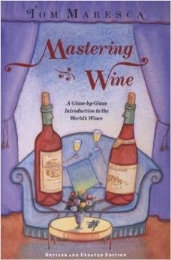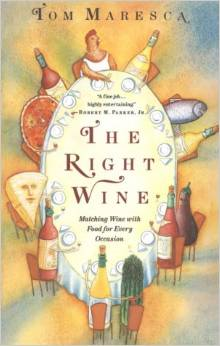A few weeks ago, I was invited to a tasting of Col d’Orcia Brunello di Montalcino vintages, sponsored by the importer, Taub Family Selections. I was quick to accept: I admire Col d’Orcia’s wines, and it was a chance to meet the newest member of the Marone Cinzano family to join the winery’s team.
 This is Santiago, son of Count Francesco Marone Cinzano, who is an old friend, a true gentleman, a canny winemaker, and a passionate guardian of the environment. Under Francesco’s guidance, the entire Col d’Orcia estate has been certified biodynamic – so, not only does it rank as the third largest acreage of vines in Montalcino but also stands as the largest fully biodynamic estate in Tuscany.
This is Santiago, son of Count Francesco Marone Cinzano, who is an old friend, a true gentleman, a canny winemaker, and a passionate guardian of the environment. Under Francesco’s guidance, the entire Col d’Orcia estate has been certified biodynamic – so, not only does it rank as the third largest acreage of vines in Montalcino but also stands as the largest fully biodynamic estate in Tuscany.
Santiago is a forceful spokesperson for all that: He is a knowledgeable winemaker, completely informed about the workings of the vineyards and winery, and in complete control of the ways Tuscany’s now constantly changing weather has affected all the vintages he presented. It was an illuminating and enjoyable morning that I and a handful of other wine professionals spent with Santiago and six fine examples of Col d’Orcia’s craft.
Here are the wines, with details of vineyard and vintage. I’ll keep the tasting notes to a minimum to avoid repetitiveness: These were all very fine examples of elegantly styled Brunello from one of the best sites in Montalcino: the southwestern slope, almost in the shadow of Mount Amiata and leaning toward Grosseto and the sea.
The first wine tasted was Col d’Orcia’s current release, the 2018 Brunello. Santiago described 2018 as a moist, mildewy year, presenting many difficulties that required careful vineyard management and great care at harvest. I found this a beautifully balanced young Brunello, with great freshness.
.
The next wine, also in current release, was Col d’Orcia’s single-vineyard Brunello Nastagio 2018. Produced from a clay-rich five-hectare site of specially selected clones of Sangiovese, after fermentation Nastagio spends two years in botti, then one year in tonneaux, and finally one more year in bottle before being released. This treatment is designed to yield a wine of more immediate accessibility than most young Brunellos. It’s meant to be what most people in the trade would call a restaurant wine – not for long keeping but for current enjoyment. I found it similar in style to the first wine, perhaps a bit more intense or concentrated and definitely more forward – quite nice and very drinkable, but perhaps not as finely structured as Col d’Orcia’s classic Brunello.
.
Santiago then offered us a preview: the not-yet-released 2016 Brunello Riserva Poggio al Vento. This wine comes from a vineyard planted in 1974, marked by sandy soil and limestone. Planting there was a brave choice then, because seemingly everyone else was aiming for powerhouse wines, and Poggio al Vento’s soil and site give elegance rather than power. The cellar treatment reinforces this – long maceration, malolactic fermentation in neutral vessels, three years’ aging in large oak (Slavonian and Allier) and then three years in bottle. I thought this was a lovely wine, with beautiful, maturing aromas, deep cherry and sotto bosco flavors, and an amazing finish. Santiago thought this might be the best vintage of Poggio al Vento in Col d’Orcia’s history, which is saying something indeed.
.
 .
.
The fourth wine was the current release of Poggio al Vento, the 2015. In a blind tasting, you would spot this as a Brunello di Montalcino by its big earth-and-black cherry aroma. This was a fine wine, though it suffered a bit by following that exquisite 2016: A presenter more oriented toward garnering sales than providing information would have shown it first. As it was, it showed soft and round, with a little tingle from some still firm tannins and slightly less acidity than the ’16.
.
The wine I had been waiting for came next: Brunello Riserva Poggio al Vento 2004. ’04 was a very great year in Piedmont and scarcely less so in Tuscany; and this example did not disappoint. A beautiful mature Sangiovese nose preceded a wine big but elegant: dark cherry flavors, with great acid/tannin/alcohol balance. All the component flavors were still fresh, but deep, and very long-finishing. I thought the cork should have been pulled hours before, because the wine still wasn’t fully open. This extremely fine wine still has years – maybe decades – of life before it.
.
The final wine was the classic 1995 Brunello – classic in every sense of the word. Santiago said it was Col d’Orcia’s last old-style harvest: It began on October 9. Harvest is now a whole month earlier. The wine’s aroma announced its maturity: earth and mushroom and undergrowth predominated. In the mouth, it was round and soft, positively velvety, with wonderful porcini and sottobosco notes. It finished long, still showing black cherry and more underbrush, and still fresh and live – seemingly having years yet to go.
.
These were great wines from great winemakers, and it was for me a great treat to be there to enjoy them, courtesy of a great friend, Bethany Burke, PR director of the Taub firm. Thank you, Santiago, and thank you, Bethany.





































